HOW BABYLON 5 IS TRANSFERRED TO DVD
© 2001-2007,2021 Henrik Herranen
This page is http://www.iki.fi/leopold/Babylon5/DVD/DVDTransfer.html
How Babylon 5 Is Transferred to Video
1. Disclaimer
Everything presented here is based on what JMS (Joe M. Straczynski,
series creator, scripter, producer, our hero, etc...) has said over the
years, combined with experimental and reverse-engineered data. Although
I cannot absolutely guarantee that 100% of what is presented here is
completely accurate, I believe that this presentation is essentially
correct, and as a professional in signal processing and a video
technique enthusiastic for 20 years, I also strongly believe the
reverse-engineered data to be correct
(and I have proof).
This article was originally based on the R1 The Gathering /
In the Beginning DVD. With the new 16:9 episodes, while transfer
of live footage has been excellent (with the exception of film dirt in
the two first seasons), the effects have consistently been handled in a
less-than-stellar way. This is especially maddening as the source material
is inferior to the film material to begin with. Making it worse than it could
potentially be makes one hope that there are multiple copies of the
original 4:3 composite tapes so as to make it possible for
someone to do the job properly in the future.
2. Motivation
In 2001, spent several days preparing this article with the main motivation
of getting to see Babylon 5 on DVD in as high quality a presentation
form as possible. In 2007 we know that never happened, but this
article will still remain here as a reference to anyone interested in
why the NTSC Babylon 5 DVDs look the way they do.
3. Abstract
This document will present how Babylon 5 is transferred from film and
computer files to the video presentations available today on NTSC VHS
video, broadcast and NTSC DVD releases. Emphasis
will be laid on the DVD release as it has the potential to be the
definitive release of the series. PAL masters will not be discussed
as extensively since issues involved with making a proper PAL transfer
are too complicated for the scope of this article.
Although DVD has vast potential for presenting Babylon 5 in its
long-awaited widescreen presentation, there are several hazards in
the process, which will be discussed in this article. The main problem
is that while the complete series (except The Gathering) was shot in a
widescreen aspect ratio, special effects shots were not properly
prepared in order to create a good-quality widescreen presentation.
Even worse, it will be shown that the current methods of making
effects widescreen are far from ideal. A solution for the problems is
also presented.
4. Some Video Aspect Ratio Terminology
Before I go to the main article body, I must make you aware of
certain aspect ratio details. The scope of these words are somewhat
larger than defined here, but I'll only use the words in the sense
defined here.
4:3 - The conventional NTSC aspect ratio you see on TV every day.
Contains approx. 480 visible horizontal scanlines.
: Babylon 5's original transmissions, VHS tapes and Laserdiscs
are offered in this aspect ratio.
Letterbox or LBX - A way to present Babylon 5's 1.78:1 material on
a traditional 4:3 tv. With this method a widescreen image is shrunk
so that it fits to a regular 4:3 TV. An unfortunate side
effect is that one fourth of the active image area is
left unused because of black bars that appear on top and
bottom of the picture. Thus, in the visible area you have
only 360 scanlines left.
: SciFi Channel's Babylon 5 transmissions are offered in this
aspect ratio.
Anamorphic, 16:9, or Anamorphic 16:9 - A way to encode widescreen
material so that there are no unused scanlines (in Babylon 5's
case). The idea is that while squeezing the image horizontally
so that the full width of 1.78:1 material can fit in a 4:3 TV,
the same squeezing is not done vertically. Thus, if you watch
a 16:9 transmission on a regular 4:3 TV set, people and things
appear thin and tall. All 16:9 TV screens can show this data
in the correct aspect ratio, as can 4:3 TVs with a so-called
"16:9 squeeze button", a feature very common in Europe. The
benefit of this approach is that you can have widescreen
material and still retain all 480 scanlines. DVD players can
convert this data to regular letterboxed material for people
that can't do the unsqueeze in their TV sets, but in this case
all the benefits of 16:9 encoding are lost, and you are back
to 360 visible lines.
: Babylon 5 DVDs (except The Gathering) are offered
in this aspect ratio.
Widescreen or WS - A Widescreen (1.78:1) image, achieved on video
either by Letterboxing or by an Anamorphic transfer.
5. A Bit of History
When the Babylon 5 series first started airing in January 1994, the
series creator Joe M. Straczynski (JMS) told that the series is
actually shot in a widescreen ratio so as to make it HDTV compatible
when the time comes. Ever since, fans have waited for a chance
to see Babylon 5 in its "intended" aspect ratio of 16:9 (1.78:1), or
1.85:1, or whatever the exact correct aspect ratio would be.
In 1991, seven years after the series begun, SciFi Channel started presenting
Babylon 5 in letterboxed widescreen. While there were some problems
with some effects incorrectly composited (remember The Teapot from
MotFL?), and some whole seasons transferred incorrectly, these errors
were corrected for later showings and it was generally felt that
these were the definitive editions of the series - so far.
Almost eight years since the first regular episodes of Babylon 5
aired, first telemovies The Gathering and In the Beginning
were been transferred to DVD for anyone to buy, soon followed by the
complete series. While The Gathering
was always intended to be presented in 4:3 and is thus of little interest
to this article (except that the transfer is proper and special effects
work as they should), all other movies and episodes have been transferred in
an anamorphic 16:9 aspect ratio, which is generally the best way to encode a
widescreen DVD.
6. Theory of Transferring Babylon 5 to Video
6.1 How Babylon 5 Goes from Film to Video
Babylon 5 is shot on regular Super-35 film at 24 frames / second.
Depending on the application, Super-35 has an aspect ratio of roughly
1.65:1. Sound is not recorded on the actual film, but on separate audio
recorders. Thus, Super-35 is not a format fit for presentation, but
for recording it is just fine.
After a show has been shot, the Super-35 film is transferred to a
digital, high-resolution format. The good thing about using a
high-resolution format is that later you can use that master to scale
several different resolution versions (NTSC 4:3, NTSC 16:9, PAL, etc)
without noticeable quality loss.
6.2 How Babylon 5 Special Effects Go to Video
Babylon 5's special effects have always been generated at NTSC
resolution (approx. 720x480 pixels), 30 frames per second, for the TV
aspect ratio 4:3. This holds also true for composite shots, i.e. those
shots that have mixed live action and computer imagery.
There are several implications of the figures described above, and they
all come down to this: there is no high-resolution master for the special
effects shots. Thus, if anyone wants to make a Babylon 5 transfer to any
other resolution or aspect ratio than standard 4:3 NTSC, it is simply
impossible to retain full video quality. The only question is how
much quality will be lost.
7. Examples of Transferring Babylon 5 to Different Aspect Ratios
This chapter will present you reconstructed examples of how
Babylon 5 is transferred to video. The word "reconstructed" is there
because I naturally don't have access to the original, digital master
files.
All examples are presented vertically at approximately 1/2 of NTSC
resolution. Horizontally the pictures have been scaled so that normal
4:3 images have a correct aspect ratio.
Resolution of the high-resolution images are not to be taken literally.
I have no idea of what resolution is used in the editing system.
7.1 Example: Live Action Material
![[Live Image, High Resolution]](Img/LiveHiRes.jpeg)
Above you can see an original, scanned Babylon 5 Super-35 frame, in an
aspect ratio of 1.65:1. Because the resolution of the film frame greatly
surpasses the resolution of NTSC (or PAL, for that matter), it is
easy to choose any area and zoom into that.
![[Live Image, High Resolution, Boxes]](Img/LiveHiResBoxes.jpeg)
This is an example of how 4:3 (blue box) and Widescreen (red box)
versions could be transferred from the current shot. Note that although
I have chosen to make the boxes as big as possible, their size can be
adjusted on a shot-by-shot basis if some details are to be emphasized.
![[Live Image, 4:3]](Img/LiveLoRes4to3.jpeg)
In this picture we see the final 4:3 transfer. As the original
high-resolution image has been scaled down, the end result still has
full NTSC resolution and may look very good indeed.
![[Live Image, Lbx]](Img/LiveLoResLbx.jpeg)
![[Live Image, 16:9]](Img/LiveLoRes16to9.jpeg)
These two images show how Letterboxed and 16:9 transfers would look.
As with the 4:3 transfer, both are as sharp and clear as they can
be, although the 16:9 transfer would look better with a proper 16:9
capable display device, as it has retained more information of the
original high-resolution scan.
7.2 Example: Composite and Computer Generated Material
In the previous example, we had the luxury of starting with a
high-quality, high-resolution film frame. Unfortunately this is no
longer the case with composite and CGI shots. For economical reasons
they were rendered only with 4:3 NTSC resolution, with the thought
that when higher resolution scans would be needed, computing power
would be so cheap that regenerating the effects would be a trivial
matter.
Unfortunately this theory was wrong. Regenerating effects would need
a lot of handcraft and is at least for now outside the range of
things that can be realized. Thus, we have only original 4:3
NTSC frames to begin with.
![[Composite Image, 4:3]](Img/CompLoRes4to3.jpeg)
As can be seen, we have much less room to manoeuver than with the
live action data. How can we get a widescreen transfer out of an image
that does not have any extra side information?
There is only one way: cropping. Babylon 5's effects are supposedly
generated in such a way that allows for matting the top and bottom of
images so that you would get the correct aspect ratio.
![[Composite Image, Lbx]](Img/CompLoResLbx.jpeg)
Above you can see the cropped version of the 4:3 image. If, as in this
case, the image is protected in such a way that no important
information is lost when cropping, this is not such a bad way of making
a widescreen transfer: the part of the picture that is not lost to the
black bars suffers no resolution loss as it is not touched in any way.
Thus, SciFi Channel's letterbox Babylon 5 has pretty much untouched
special effects, with full picture quality - unless someone has screwed
up something.
Finally, we'd want to make the ultimate, 16:9 transfer. And it is here
we run into trouble, big time.
To create the 16:9 version, we should start with the previous letterboxed
image, since that's the best and only widescreen image we have available.
This image that has 360 active scanlines must be converted to an image
that has 480 scanlines. (Note, that as my images are at half resolution,
they have 180 and 240 active lines, respectively.)
It is probably very easy to understand that when upconverting something
from a lower resolution to a higher resolution, you cannot expect the end
result to have the full resolution that the higher resolution image can
present. What may not be quite as intuitive is that you cannot even get to
the resolution of the lower-resolution image!
What am I saying? Yes, I am actually saying that for a 16:9 letterboxed
transfer, there is no way that the composite and effects shots can look
even as good as in the Letterboxed version. The difference need not be
big, but 16:9 will in this case necessarily be worse than letterbox.
Does this sound a bit nasty? Sorry, it's worse than that. See the
pictures below for the gory details.
![[Composite Image, 16:9 Transfer]](Img/CompLoRes16to9.jpeg)
![[Composite Image, 16:9 Suggestion]](Img/CompLoRes16to9Leo.jpeg)
Above you see two pictures that show how the 16:9 transfer could be done.
The picture on the left is the way the resolution conversion has actually
been done, and the picture on the right show how I would do it. Let's look
at the pictures again, but this time upscaled:
![[Composite Image, 16:9 Transfer]](Img/CompLoRes16to9.jpeg)
Above: The way Babylon 5's anamorphic version is actually done.
![[Composite Image, 16:9 Suggestion]](Img/CompLoRes16to9Leo.jpeg)
Above: The way I would scale Babylon 5 to 16:9 anamorphic.
As you (hopefully) see very clearly is that the picture
presenting the way Babylon 5 has been transferred, looks quite bad. Some
horizontal lines have been doubled, and the picture's overall look is
fuzzy and unclear.
You may have scaled bitmap pictures on a computer without ever getting
results this bad.
You might even ask yourself: "Surely nobody would be so stupid to make
such an ugly transfer when it's so easy to make it properly." That's a
good question. Unfortunately, in the video world, scaling gets a bit
complicated. This will be described in the next chapter.
8. Field-based Vs. Frame-based Video Transfer
One nasty detail in video picture that always (including this case) comes
to bite you in the ankle is that unlike film frames, video picture is
transferred not in frames, but in fields. I won't go into details in why
this choice was made in the late 1930's, but suffice to say that it
made it possible to transfer a HDTV signal (as NTSC was called at that
time) in approximately half the bandwidth that would otherwise be
required, allowing for two times the number of channels otherwise
available.
![[Interlaced Video Picture]](Img/FrameField.gif)
The example picture above shows how a hypothetical, 12-line interlaced
TV system works. To show the full frame, first odd scanlines are
presented. After this, even scanlines are presented. If presented fast
enough, these two video fields meld in the brain and form the full
frame presented on the left.
Short summary: as all other analog video systems, also NTSC uses interlaced
video. NTSC's field rate is 60 Hz (actually 59.94 Hz, but who's counting?), and
the frame rate is half of that, roughly 30 Hz.
It is no coinsidence that Babylon 5's special effects have been generated
at this same rate, 30 frames per second. It has the potential of making
movement look smooth and nice compared to 24 fps live action material,
which needs some tuning to fit into the 60 fields/s video system.
Now that we understand these basics, we can finally have an informed
look at how Babylon 5's special effects are converted to 16:9.
![[Video Signal Path]](Img/SignalPath.gif)
Originally, when Babylon 5's effects were created, they were rendered
at 30 fps, and stored to a computer in this format (F1, F2, F3 and F4).
To transfer the images to video, they are separated into video fields.
For instance, F1 is broken to f1.1 and f1.2. Likewise, F4 is broken
to f4.1 and f4.2. At some point the data is letterboxed. Although it
doesn't matter where this is done, I've presented the step here for
clarity. Thus, we've now lost the supposedly unimportant bottom and top
of the effects shot. It is worth noticing that at this point, the
information of which field-pair contain data from the same source frame,
is lost. Thus, while f1.1 and f1.2 represent the same frame in this example,
this could also be the case for f1.2 and f2.1 (f2.1 not shown in the picture).
Signal path A presents how Babylon 5's transfer is done. First A1 removes
the unneeded letterbox lines. Then, A2 upscales the picture by 33%
vertically. This is the very step where picture clarity is lost. A3
regenerates interlaced fields. A4 isn't necessarily performed at all, but
the combined frame F'1 is a convenient way to show how the end result will
look on your screen.
What went wrong with transfer A? The problem is that upscaling was done to
interlaced video fields which, if taken from a signal processing view, is
horrific mishandling of a completely innocent signal.
So, how should things be done then?
Signal path B shows my suggestion of how the effects should be transferred.
First, F4 is broken to video fields f4.1 and f4.2 just as happened with
F1. But in this case, B1 combines two video fields to create a full frame.
Then, this complete frame is upconverted to create directly F'4. If needed,
interlaced fields can be easily created from F'4 if that is required.
You may again ask why Babylon 5 isn't converted in this way which
seems so much easier to do. The reason is that there is really no guarantee
that the original fields are aligned. Also, Babylon 5 has several shots
where live action is in 24 fps but CGI is in 30 fps, making it impossible
to sync perfectly to the source signal's frame rate(s). It is worth noting
that if field-combining fails, the end result will look considerably worse
than any of the methods presented here. Thus, to get correct conversion,
there needs to be automatic logic combined with some human
interaction for verification.
There are two reasons why I am so concerned with this. One is that I wanted
to have Babylon 5 on DVD with as high quality as possible. The other is that
I know the problematics involved in making these effects. My
company created a working prototype 3D graphics chip in the late 1990's.
The evaluation card that had the chip had both TV
inputs and an output. In addition to defining the chip's interlace flicker
filters, I made some software to the card that did exactly what I
described earlier: it scanned an NTSC, SECAM or PAL signal, examined
movement and used the detected movement to sync to the actual frame rate
in the source material. When executed properly, syncing worked very well
and the system worked wonderfully with video projectors and
computer monitors, and allowed for clean video conversions across video
systems.
9. Summary
If given original 4:3 or Letterboxed Babylon 5 effects video
fields in some known high-quality digital video format (plus
some time and money), I could make a better CGI + composite
transfer than what current DVDs show. And after all these
years, now that it is 2007, I still am sorry that the shots
haven't been transferred in the best possible way to widescreen.
Not at all diminished by the terrible later TV movies, original
Babylon 5 is still great and needed the best possible DVD transfer.
Finally: Proof 2003-04-21
When I originally wrote the previous article more than a year ago, I had
strong feelings that my theory was correct. However, because no-one could
provide me with high-quality, bit-accurate B5 DVD scans, I couldn't
really prove everything that I said. Now I can.
Below is one frame digitized from the very first shot of Midnight on
the Firing Line, from the R1 DVD (which is, actually, region-free).
This is one of the last frames of that first shot. I have taken the
liberty to crop extra black space away to make the file and image slightly
smaller. I also made it black and white to ease my own job and to make
the artifacts appear more clearly. The frame is presented below:
![[Example 1]](Img/b5_1_1.jpg)
Now that I finally had good, accurate frames ripped straight from the
DVDs, I immediately decided to try to compensate for the wrong
filtering that I described earlier in this article. The task proved to be
doable in four hours and resulting in merely 3.5 kilobytes of C source
code. The reverse-handled and rescaled image is below:
![[Example 1]](Img/b5_1_2.jpg)
So, there it is. Download the two images and flip through them back and
forth. Imagine the images on a big projection-screen television where all
differences appear 10 times bigger. There you have it.
I have used no extraneous edge enhancement or other dishonest trickery
to prove my point, and I very much doubt that they would have been of any
help, as I was trying to regain real resolution that actually
existed in the original 4:3 masters.
What my software did was as follows. First it divided the original interlaced
frame F'1 to two interlaced fields. Then I used reverse
filters to acquire f1.1 and f1.2, and then combined them to produce the
original, letterboxed frame F1. After the original, unbroken complete
frame F1 had been regenerated, it was used to create F'4, which
was scaled in the way it should be done.
The result is what you see above.
If you for some reason can't easily compare the pictures above, I've
prepared two partial enlargements of them, where the original broken
frame F'1 and my corrected F'4 are shown alternatively. The picture
that looks unclear and where some details appear two times is the
original, and the sharper one is my properly scaled version.
Detail 1:
![[Example 1 AnimGif]](Img/b5_1.gif)
Detail 2:
![[Example 1 AnimGif]](Img/b5_2.gif)
This was what I would have liked to have seen in the Babylon 5
16:9 DVD transfers.
Subtle Differences Between R1 and R2 DVDs
There has been some talk about how R1 (actually all-region) and R2 versions
of Babylon 5 first season DVDs have some CGI transfer errors, and that they
appear in different places in the two existing versions. What has been
talked less about is that the CGI and composite shots for these two
versions seems to subtly vary all over the place so that the watcher of
both versions seems to get a picture that these shots have been
transferred independently of each other. If this sounds improbable,
see for yourself the very first shots of the first five acts of Signs
and Portents.
The following pictures have been scaled to similar size to make
comparing easier. No cropping has been done. I have made it certain
that all image pairs are aligned in time with the accuracy of one frame.
| Nr | R1 | R2 |
|---|
| 1 |
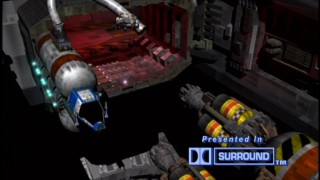 |
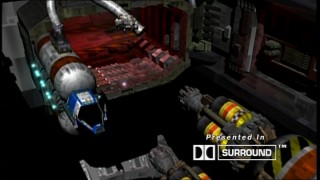 |
1: In this first picture, which is from the first shot of SaP,
there are two differences: the pictures are vertically aligned
ever-so-slightly differently. More notably, however, is that
the Dolby Surround logos are different: the R1 logo is larger
and it is blue. The (tm) sign is in a different place,
and although it doesn't show in pictures this small, the shadows behind
the letters are slightly different.
| Nr | R1 | R2 |
|---|
| 2 |
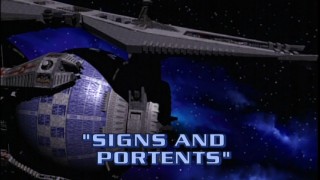 |
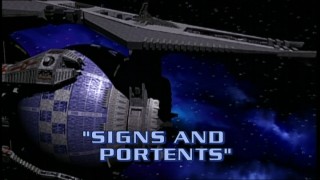 |
2: This picture pair, after the opening titles, again show two slight
differences. The R2 version shows the station slightly higher. Also the
alignment of the two text lines are slightly different: In R2, the D of
"and" and the S of "portents" are aligned, in R1 the words are
centered better. This proves that the texts are not from a common bitmap
source.
| Nr | R1 | R2 |
|---|
| 3 |
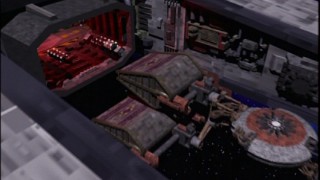 |
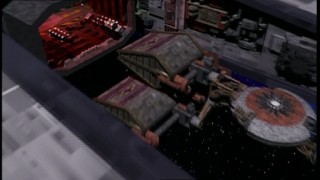 |
3: This is the end of the same shot used in example 2. Now the framing
difference is obvious: R2 shows the image much higher. I would prefer
the framing of R1, because it shows more of the port.
| Nr | R1 | R2 |
|---|
| 4 |
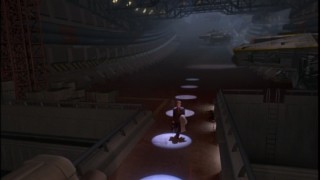 |
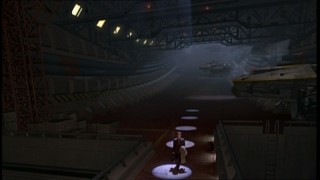 |
4: Just a few frames after example 3, right after the cut,
Mr. Morden's first appearance in Babylon 5 is framed completely differently
in the two versions.
Although R2 shows more ambience for this very beginning of the shot, it
lets Mr. Morden walk half-way off screen before panning down (not
shown in this picture). R1 does this better and doesn't let Mr. Morden
partially out of the screen before just a second before the end of the shot.
| Nr | R1 | R2 |
|---|
| 5 |
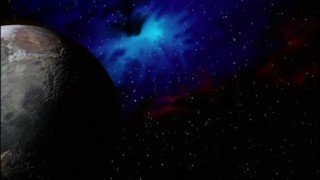 |
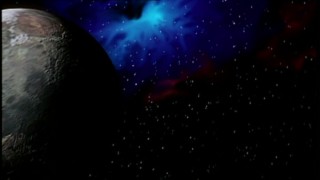 |
5: Here at the beginning of chapter 3, R2 shows the image a bit higher.
| Nr | R1 | R2 |
|---|
| 6 |
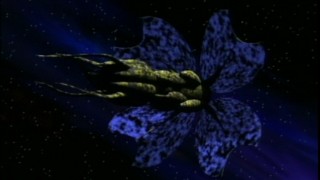 |
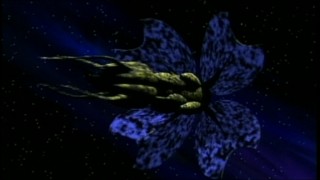 |
6: The framing of Kosh's ship at the beginning of chapter 4 is pretty much
the same in both versions.
| Nr | R1 | R2 |
|---|
| 7 |
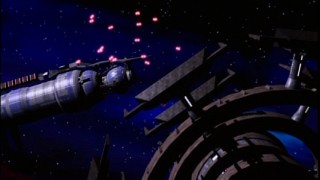 |
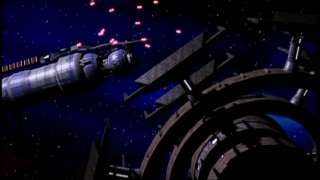 |
7: Again, R2 shows the image somewhat higher, and cuts some fighter ships
in favour of the mother ship in the front. Again, I'd prefer the framing
of R1.
All these subtle differences leads me to believe that for some odd reason
the R1 and R2 DVD masters were cropped, and the titles were added at different
times, perhaps even by different people. The reason for this escapes me.
Perhaps JMS would have some insight into this?
Second Season: Special Effects Still Problematic
I have just had a chance to check the Second Season of Babylon 5 on
NTSC DVDs. As I assumed from the Second Season PAL edition, the
special effects are transferred in exactly the same way as I have
described in this article. Also the considerable amount of film dirt
in live footage has remained.
There are also additional errors in the 2nd Season set, most
annoying for me being the opening title font which is not the same as it was
when Babylon 5 was first aired in its NTSC incarnation (but, curiously
enough, it is the same as was used in first proper PAL versions). Also
the end title music is wrong: instead of the Second Season faster
theme, the First Season theme has been used. And, in the NTSC version,
Delenn's image is wrong in the two first episodes (it should be an
image of First Season Delenn, as it correctly is in the PAL version).
As with the First Season, framing of SFX is different in PAL and NTSC
versions. This can be seen, for instance, in Fall of Night's
Keffer's Starfury's surveillance camera shots: in the PAL version,
the word "Keffer" is completely visible, while in the NTSC version,
only the upper part of the letters can be seen (and the NTSC version
flickers like crazy on a proper 16:9 display device because of the
way the SFX are converted).
While all of this did not stop me from buying five copies of the
PAL Second Season box set for me and my friends, I would really,
really wish they would try to get their act together for
Season 3. It's really not that hard. And, really, there are
no alternatives since the later 2nd Season and all of the
3rd Season were never published on Laserdisc.
Third Season: New Visions
Third Season Picture Quality
I have finally had a chance to have a look at the R2 (PAL) version
of Babylon 5's third season. The first thing to say is that they
have obviously finally cleaned up practically all of the
film dirt. Although the cleaning process has lead to some
artifacts (Army of Light uniform stripes sometimes disappear
with even slow movement), the overall result is very good. There
are some places where there is notable film grain, but they
obviously come from the original camera negatives as a result
of insufficient light during shooting.
The only gripe I have with the live action footage is that the
framing looks to me much more 4:3-oriented than what it was
during the first season. A notable exception is War Without End
Part 1 which seemed to make full use of the 16:9 area. One
distracting thing, though: all first season footage for both
War Without End episodes have been transferred using the
special effects process, i.e. 4:3 cropped to 16:9. This is also true
for all reused footage in black and white flashback scenes. (By the
way, when flashback footage is B&W anyways, wouldn't it had been
clever to show it also in original 4:3 format to underline that it
is old? Now they lost a chance not to crop the 4:3 footage
even further.)
I expect to get my hands on the R1 version in a few weeks, and then
I'll comment more on the effects transfer. However, judging from the R2
transfer I saw, it might actually be that they have done it
slightly differently this time around. But no definite comments
before I actually have a chance to see it.
How Much Quality Do We Lose With Composites?
Background
I have stated many times in this article that quality is lost because
4:3 NTSC masters have to be used and cropped to create CGI and composite
shots for Babylon 5. And I have also stated that more quality is lost
than what would be absolutely necessary. You might however had the
following quesion: "How much is lost, then?" Interestingly
enough, I can now give a definite answer.
For some reason all reused footage from past seasons and episodes are
presented in the 4:3 -> 16:9 cropped format even if they don't contain
any computer graphics. Thus, to see how much is lost from the original,
high-quality film material, you only have to have a look at the
"Previously on Babylon 5" sections of War Without End or A
Voice in the Wilderness and compare them with the places where
those shots were originally used. I've selected to do exactly this
with War Without End.
Before we go to the actual pictures, let me make one thing absolutely
clear. I am not, repeat not claiming that cropped 4:3 could be
made to look as good as original film material without completely
recreating all special effects, which as we know is inpractical, and
if done would probably lead to something akin the Star Wars travesties.
This is because all original CGI models and setups have been
lost. Here I am just showing how big the difference is without
commenting a lot on how much of it would be avoidable.
Pictures
I have used the R2 (PAL) version of Season 3 for this
demonstration. All pictures have been decoded as is from DVD, then
rescaled to 1024 horizontal resolution to get to the correct
16:9 ratio. The images were compressed to JPEG format. The first picture
pair in each table is the Real 16:9 vs 16:9 cropped from 4:3, both
scaled down (click on the pictures to see the big ones). The
second picture pair is a selected small detail in normal scale.
| Nr | WWE1 Real 16:9 | WWE2 Cropped 4:3 to 16:9 |
|---|
| 1 |
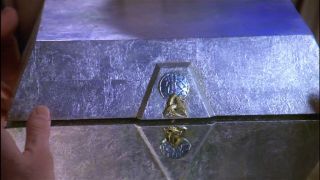 |
 |
| 1 |
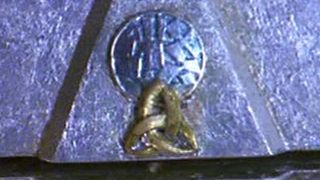 |
 |
In this first image, we see Ranger One opening a thousand years old box.
Perhaps a little bit surprisingly, not only the sharpness is better in
the new scan, but also contrast and colours. It looks like the 4:3-to-16:9
transfer could have been a bit better with extra tweaking. (I ran some
tests, and could never really make the contrast and colour of the
4:3-to-16:9 version match the superior 16:9, so it would probably not
be trivial.)
| Nr | WWE1 Real 16:9 | WWE2 Cropped 4:3 to 16:9 |
|---|
| 2 |
 |
 |
| |
 |
 |
In this picture pair we see that the patterns on the Army of Light
uniform are much clearer in the new scan. Also Ivanova's skin tones
are better.
| Nr | WWE1 Real 16:9 | WWE2 Cropped 4:3 to 16:9 |
|---|
| 3 |
 |
 |
| |
 |
 |
Notice how the flatness of the 4:3-to-16:9 transfer version makes the ranger
pin look dull and not very shiny.
| Nr | WWE1 Real 16:9 | WWE2 Cropped 4:3 to 16:9 |
|---|
| 4 |
 |
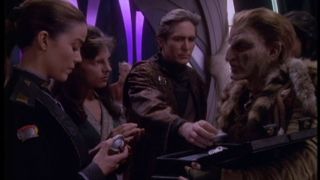 |
| |
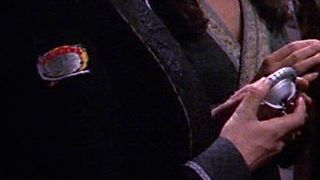 |
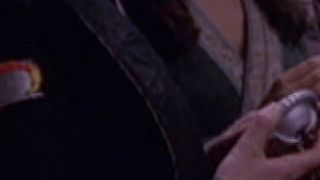 |
Again, it's not only sharpness: the arm emblem and the time stabilizer
look a lot more metallic in the new transfer. The question is: how come
the 4:3 cropped version could look this much worse contrast-wise?
After all, the episodes surely never looked that dull when first shown
on TV (or when published on Laserdisc as original 4:3 versions (btw,
when I get the chance, I'll post some picture comparisons that also
have a 4:3 Laserdisc transfer as reference (of some episode that is
available both on Laserdisc and DVD))).
| Nr | WWE1 Real 16:9 | WWE2 Cropped 4:3 to 16:9 |
|---|
| 5 |
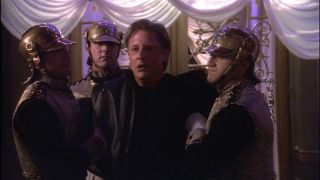 |
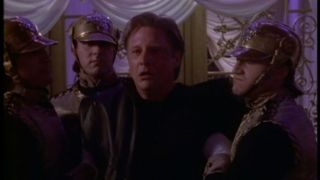 |
| |
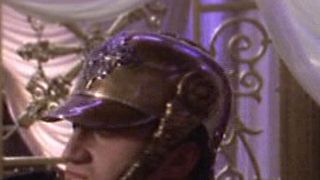 |
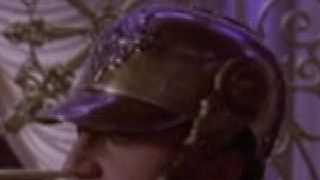 |
There really isn't that much new to say: the picture quality is
way better in the 16:9 transfer, and that's it. Notice, however,
that remnants of the jaggies that were so present for two first
season R1 transfers are conspicuously absent in this Season 3
R2 transfer, which might be or not be a hint for the R1 transfer.
But I'll comment more on that when I have the actual R1 discs in
my hands.
Third and Fourth Seasons: Nothing New in NTSC Land
I've finally had a change to have a look at the NTSC 3rd and
4th Seasons of Babylon 5. As commented earlier, there is much
less dirt in the film transfer portions, probably due to digital
cleanup. This is very good, as the amount of dirt in some scenes was
- quite frankly - distracting.
Special effects and composite
shots are, however, still converted in the very same half-ass way as
before. In addition, there are some errors and weirdnesses common to
both NTSC and PAL transfers. The whole Garibaldi arc in the beginning
of Between the Darkness and the Light is in the cropped widescreen
format, probably because of some confusion over the fact that the
particular material was originally supposed to be in
Intersections in Real Time, but was bumped to the next episode
according to JMS. Also
the opening titles of The Deconstruction of Falling Stars are
different from the one in the original airing, as Claudia Christian
in them. In the original version she was absent because of payment
reasons.
Fifth Season: Same Old, Same Old
There is little more to say about the fifth season. Special effects
are converted just as before, including the last six episodes where
SFX were supposedly created at 24 fps at a higher-than-NTSC
resolution to allow for a HDTV or film transfer. Well, the only
thing really happening is that special effects look jumpier than before.
Also, there seemed to be more film dirt than in the previous two
seasons, although I cannot really be hundred percent sure.
Too bad.
All in all, I've found the Babylon 5 DVDs to be a mixed bag.
First and foremost I am really, really happy that they
exist at all. Also, the new film transfers have improved
picture quality significantly - or would have if there weren't
quite that much film dirt. However, at the same time I still
cringe because special effect shots were not handled as well as
they could have, recropping them and thus breaking both
picture composition and quality. Leaving effects and
composite images at 4:3 along the 16:9 (or slightly narrower)
film material would certainly have given the best picture quality.
All in all, even with all its shortcomings, I'd recommend Babylon
5 DVDs for anyone even slightly interested in science fiction or
good storytelling - especially the inexpensive German edition.
2005-03-10: The Movie Collection (R1)
The Babylon 5 Movie Collection continues with 16:9 traditions
described earlier in this article.
The Gathering
The video transfer for The Gathering seems to be the same that was
earlier used for the The Gathering / In the Beginning double feature
disc: the picture looks like it has been converted from a composite
source and is somewhat soft and flat. Also the subtitles are the
same as before, with some unintentional humour (like Dr. Kyle's
line that has changed from
"I have looked upon the face of a Vorlon, Laurel." to
"I have looked upon the face of a Vorlon. Horror.")
However, audio has been updated to 5.1 and although there are no
big surprises there, dialogue stays nicely in the center channel.
The JMS and John Iacovelli commentary is insightful as usual
(haven't listened to the other commentaries in this box set yet).
This movie serves as a good example of how good CGI and
composite shots looked before being cropped and badly scaled for the
16:9 versions.
In the Beginning
This transfer is probably the same as in the The Gathering /
In the Beginning double feature disc, but it has been cleaned up:
at least some of the biggest hairs have been removed.
A good example of removed hair is at the very
beginning when Delenn utters the first words of her first line:
"It is said...". As with many 4th Season episodes, there
often are considerable amounts of film grain.
Special effects have been transferred as always.
Audio has been updated nicely to 5.1.
Thirdspace
This movie, along with being arguably the low point of entire Babylon 5
(yes, in my opinion below TKO and Infection),
shows film grain that would be bad for 16-millimeter stock.
I don't know what they did during shooting of Season 4, whether
it was all-new second grade film stock or if they
stopped lighting the sets and thus were forced to overcrank
their film footage in post production, but something was seriously,
seriously wrong with picture quality during this time. Film grain was
evident in In the Beginning, but this movie just looks
unbelievably grainy.
The River of Souls
Somewhere between the 4th and 5th Seasons,
the Babylon 5 crew learned again how to shoot clean, noiseless
film footage. Thus, the last two TV movies which were shot
after the 5th Season of Babylon 5 look significantly
better than the earlier telefilms.
The River of Souls is a nice, clean transfer (with the natural
exception of special effects and composite shots). However,
as special effects are rendered only at 24 fps instead of
30 fps that had been used earlier, and as the effect shots have not always
been properly motion blurred, movement can at times look jerky.
One opportunity missed was flagging the material as a 24 fps source.
During earlier seasons this would have been problematic because of
mixed frame rates. However, now it would have been possible and
would have made it easier to watch the DVDs with some progressive
devices. However, the material is incorrectly flagged as 30 fps.
A Call to Arms
This is a transfer similar to The River of Souls. As a
special effects heavy show, this movie particularly suffers
from special effects cropping.
2005-03-09: Crusade (R1)
Because of budget restrictions, Crusade didn't get a new 16:9
transfer for DVD. While a somewhat surprising decision, artistically
this was by no means a disaster. The original 4:3 masters are in
very good shape, and audio has been updated to 5.1.
As with the TV Movies, everything is now 24 fps, including special
effects. Nevertheless, the source material is incorrectly flagged
as 30 fps.
If you have a chance, have a look at this set. You will notice that
in many places it is very difficult or completely impossible to say
whether what you are looking at is pure film footage or whether it is
a composite shot. That is how Babylon 5 used to look before getting
the anamorphic widescreen treatment (which enhanced the quality of
film-only shots but decreased the quality of composite and CGI
shots).
2021-02-11 (edited 2021-02-12): HBO Max's HD Remaster of Seasons 1-5
I never thought I'd see that day, but finally, finally we have
something resembling a proper transfer of Babylon 5.
The new HBO Max's remasters include 35 mm film elements rescanned in 4K,
then downscaled to HD, effects and composite shots upscaled from 480i
composite video to 1080p, and keeping the original aspect ratio of 4:3
to keep the newly scanned film footage and special effects footage to
be as consistent as possible without a need to redo all the effects.
The result is a version that looks better than anything we've seen so
far.
Some comments:
- Live-action footage looks slightly soft for a 35 mm film HD transfer.
I am almost certain this was made on purpose so as not to make it appear
too different from the upscaled 480i special effects. Still, if you look
closely, there is still lots of detail in the true HD, particularly in
the wide shots. It's just not oversharpened. I approve of this choice.
- The effects are on a complete different quality scale when
compared to the DVDs. Particularly ubiquitous beauty shots of the outside
of the station look way better than before.
- On the 16:9 DVDs, the picture for film shots is wider than in the
original 4:3 release. On the other hand, the effects shots are
cropped to be narrower than in the original 4:3 release. This makes for
a jarring "variable framing effect" when jumping between these two kinds
of shots. All these problems are now gone with the 4:3 HD transfer.
This is the way.
- The release is in 24 fps. With the exception of 5 last episodes
of season 5, all of Babylon 5's special effects were done in 30 fps.
This leads to movement in some special effects shots to be jerky.
- Some film shots are way oversaturated, making people orange.
I know Sheridan&co are not orange. Turning colour way down makes
these shots seem more natural. Makes me wonder what makes this happen
as most shots, often even in the same scene, have natural skin colour.
- On the other hand, nobody has taken the approach of "modernizing"
the footage to have the utterly boring two-color (typically
teal+orange) look that almost everything has had for the last decade.
Thank you thank you thank you for letting the series be as boldly
colourful as it ever was!
- There are some really weird things happening with sound. At times
it sounds like the source videotapes just haven't moved at a consistent
speed. There is significant wow and flutter.
This happens only intermittently, but when it does, it
makes Christopher Franke's synthesizer score sound out
of tune, like it was made with cheap early 1980's toy synthesizers.
This was definitely not happening in the original broadcasts,
PAL VHSs, Laserdiscs, or DVDs. Frankly, this feels a weird thing to
go wrong.
(I will add examples later.)
- Three episodes are missing a couple of minutes of content. As the
series is at the moment only available for streaming, one would guess
this would be relatively easy to correct.
- Season 1 episode Babylon Squared misses everything between
the last commercial break and end titles, approximately 3 minutes.
- Season 3 episode War without End, Part 2 misses the
"Previously on Babylon 5" segment, approximately 2 minutes.
- Season 4 episode The Hour of the Wolf misses the
pre-credit sequence, approximately 3 minutes.
- The original pilot episode, The Gathering has not been remastered.
Please, please, please fix the errors (at least the missing content), and
make this new transfer available on Blu-Ray. I'll definitely buy it,
probably even several copies to give as presents to friends of old.
This page ©2001-2005,2021 Henrik Herranen
Babylon 5, characters, names, and all related indicia are trademarks of
Time Warner Entertainment Co., LP. ©1999 Time Warner Entertainment Co., LP.
![[Best viewed with any browser]](../../Img/AnyBrowser.gif)
![[Live Image, High Resolution, Boxes]](Img/LiveHiResBoxes.jpeg)
![[Live Image, High Resolution]](Img/LiveHiRes.jpeg)
![[Live Image, 4:3]](Img/LiveLoRes4to3.jpeg)
![[Live Image, Lbx]](Img/LiveLoResLbx.jpeg)
![[Live Image, 16:9]](Img/LiveLoRes16to9.jpeg)
![[Composite Image, 4:3]](Img/CompLoRes4to3.jpeg)
![[Composite Image, Lbx]](Img/CompLoResLbx.jpeg)
![[Composite Image, 16:9 Transfer]](Img/CompLoRes16to9.jpeg)
![[Composite Image, 16:9 Suggestion]](Img/CompLoRes16to9Leo.jpeg)
![[Interlaced Video Picture]](Img/FrameField.gif)
![[Video Signal Path]](Img/SignalPath.gif)
![[Example 1]](Img/b5_1_1.jpg)
![[Example 1]](Img/b5_1_2.jpg)
![[Example 1 AnimGif]](Img/b5_1.gif)
![[Example 1 AnimGif]](Img/b5_2.gif)


































![[Best viewed with any browser]](../../Img/AnyBrowser.gif)